Characteristics of Bipartite Upper Beaks
- Step: Present in Type 1 and Type 3 beaks, absent in Type 2 beaks. Located between Palatoshoulder Ridge (or occasionally Hyaline Matrix) and Jaw Edge in beak Types 1 and 3.
- Shoulder Blade: : Thin; on Outer Part of Shoulder, without an Outer Cover.
- Shoulder Blade: Presumably composed of a single Component.
- Hyaline Matrix: Forms Middle Part of Shoulder.
- Palatoshoulder Ridge: Forms Inner Part of Shoulder except in Type 3 beaks where it is virtually absent.
- Pigmentation of posterior surface of Hyaline Matrix: Begins on posteromedial side of Hyaline Matrix with the LW-B Continuum appearing to "peal-off" of Lateral Wall.
- Yellow Line: Absent.
Types of Bipartite Upper Beaks
- Bipartite Type 1: Step present laterally between Palatoshoulder Ridge (or sometimes Hyaline Matrix) and Jaw Edge at some point during ontogeny.
- Biparatite Type 2: Step absent. Palatoshoulder Ridge present but not anterior to Shoulder Blade which generally precludes Step development.
- Bipartite Type 3: Step present. Palatoshoulder Ridge virtually absent, apparently appearing only with general pigmentation of Shoulder.
Young Bipartite beaks have no Shoulder Step. As the squid grows, the Shoulder Blade often recedes/erodes revealing a new surface of the Jaw Edge. Often the Hyaline Matrix also recedes. In either case a Step is created between the Jaw Edge and either the Hyaline Matrix or the developing Palatoshoulder Ridge. A Step, therefore, only develops during ontogeny. In some species a Step never develops and the Shoulder Blade remains the anterior-most structure of the Shoulder (a Bipartite Type 2 beak). In the Bipartite Type 3 beak the Palatoshoulder Ridge never develops.

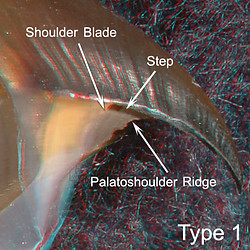

Figure. Bipartite beak types 1 & 2. Left - Gonatus berryi, 124 mm ML, ? mm URL. Right - Berryteuthis magister, ? mm ML, 5.9 mm URL.
SURVEY OF BIPARTITE UPPER BEAKS - Type 1
ORDER - Oegopsida:
The Batoteuthidae has a single species, Batoteuthis scolops.
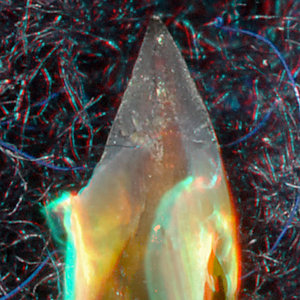 p> | 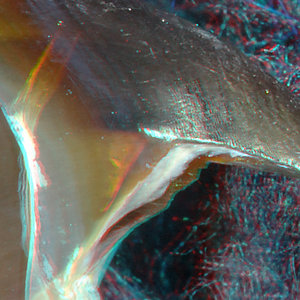 | 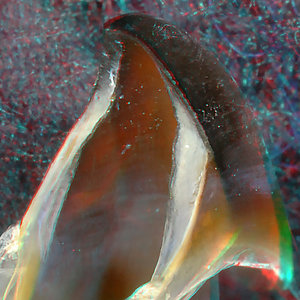 |
| Batoteuthis scolops, sex ?, 90 mm ML, 2.0 mm URL. | B. scolops, mature male, 351 mm ML (with tail), 4.2 mm URL. LEFT - Side view. RIGHT - Oblique view. | |
We have only seen two growth stages of this species. At 90 mm ML (above, Left) the pigmentation of the Lateral Wall has not yet reached the Shoulder. There appears, however, to be a small Step between the Shoulder Blade and the Hyaline Matrix. In the adult (Middle) a distinct Step is present between the Palatoshoulder Ridge and the Jaw Edge. The oblique view (Right) shows a typical Type I beak with the Palatoshoulder Ridge having a free edge and extending well onto the palate.
2. CHIROTEUTHIDAE: Chiroteuthis, Asperoteuthis
The family contins four genera: Chiroteuthis, Asperoteuthis, Grimalditeuthis and Planctoteuthis.The first two genera have typical Type 1 beaks and are treated first.
 | 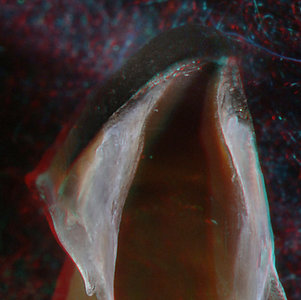 | 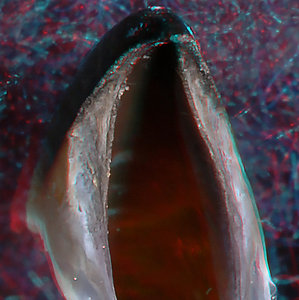 |
| Chiroteuthis picteti, sex ?, ca. 160 mm ML, 2.7 mm URL. LEFT - Side view. MIDDLE - Front-oblique view. | C. picteti, sex ?, ca. 200 mm ML, 3.3 mm URL, beak fully pigmented. RIGHT - Oblique view. | |
In the 160 mm ML Chiroteuthis picteti (above Left), the Jaw Angle (anterodorsal end of the Shoulder Blade) is well posterior to the anterior edge of the Palatoshoulder Ridge so a distinct Step is present; the well-defined Palatoshoulder Ridge has a free edge on the Shoulder that extends onto the Palate (Middle). The heavily pigmented larger beak (Right) looks quite similar but the Shoulder Blade is no longer as apparent, since pigmentation has extended over most of the Outer Part of the Shoulder; only a residue of the Hyaline Matrix is left.
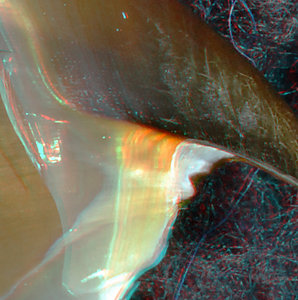 | 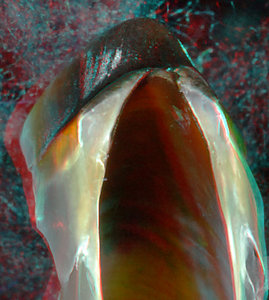 | 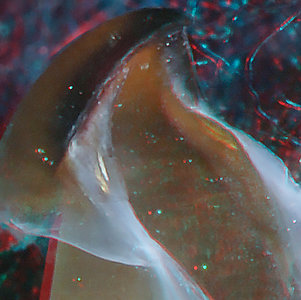 |
| Asperoteuthis acanthoderma, immature female, 300 mm ML, 5.1 mm URL. LEFT - Side view. MIDDLE - Oblique view. | A. mangoldi, mature male, 103 mm ML, 1.5 mm URL. RIGHT - Oblique view. | |
The beak of Asperoteuthis acanthoderma (above) is similar to the previous species. The Shoulder Blade is well posterior the leading edge of the Palatoshoulder Ridge (Left) and the latter has a free edge that extends far onto the palate (Middle). The mature A. mangoldi (Right) although more heavily pigmented, doesn't look much different in these general features.
2. CHIROTEUTHIDAE: Grimalditeuthis (Find Planctoteuthis under Type 2 beaks below)
Grimalditeuthis has only a single species, G. bonplandi. Its beak is unusual and could easily be placed in its own category.
 | 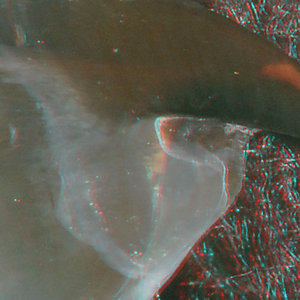 |  |
| Grimalditeuthis bonplandi, sex ?, ? mm ML, 1.2 mm URL. LEFT - oblique view. Arrow - Shoulder Blade. | G. bonplandi, sex ?, 137 mm ML, 3.0 mm URL. MIDDLE - Side view. RIGHT - Front-oblique view. | |
ARROWS: 1 - Shoulder Blade. 2 - Palatoshoulder Ridge. 3 - Shadow cast by opposite side of beak. 4 - Hyaline Matrix (the dark color is a lighting artifact).
The Shoulder Blade of G. bonplandi (Left, 1) is very small. In general, the Shoulder Blade is difficult to recognize or absent in larger beaks. The anterior end of the Shoulder Blade, in this image, extends over the posterior end of a large embayment of the Hyaline Matrix, indicating a Step exists between the Jaw Edge and the Hyaline Matrix. The Palatoshoulder Ridge (2), strangely, is deeply embedded in the Hyaline Matrix. At 137 mm ML (Middle, Right) the Palatoshoulder Ridge looks rather normal and creates a large Step, partially due to the unusual concavity of the Hyaline Matrix. The Ridge terminates, however, at or near the base of the palate. Most of the medial side of the Ridge is covered with Hyaline Matrix.
3. MASTIGOTEUTHIDAE
The family has six genera: Mastigoteuthis, Idioteuthis, Mastigopsis, Echinoteuthis, Magnoteuthis and Mastigotragus.
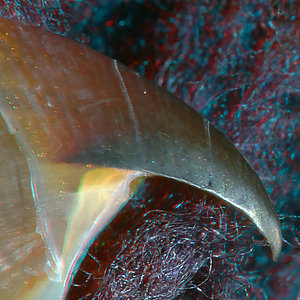 | 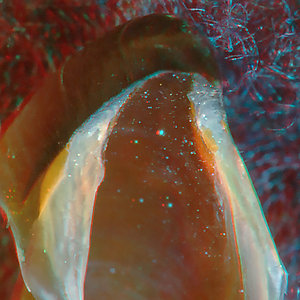 |  |
| Mastigoteuthis agassizii, 78 mm ML, 3.2 mm URL. LEFT - Side view. MIDDLE - Oblique view. | M. agassizii, 118 mm ML, 3.3 mm URL. RIGHT - Oblique view. | |
In the smaller beak of Mastigoteuthis agassizii (above) the Palatoshoulder Ridge is the most anterior part of the Shoulder creating a Step between it and the Jaw Edge (Left). The Ridge has a free edge and extends well onto the palate (Middle). The adult (Right) looks similar except that the middle layer is sclerotized with only a white residue of the Hyaline Matrix on its surface. This is a typical Bipartite Type 1 beak.
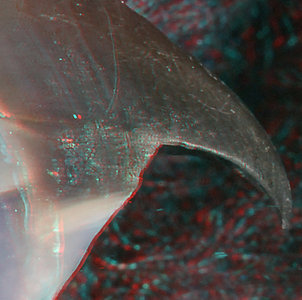 > | 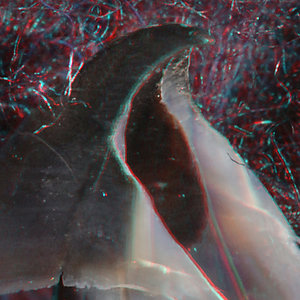 | 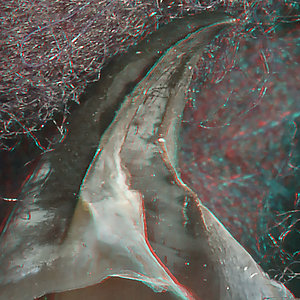 |
| Idioteuthis cordiformis, immature female, 86 mm ML, 2.0 mm URL. LEFT - Side view. MIDDLE - Oblique view. | M. pyrodes, mature female, 145 mm ML, 5.0 mm URL. RIGHT - Oblique view. | |
This young beak of, Idioteuthis cordiformis (above Left, Middle) has a typical Bipartite Type 2 beak at this stage of development. However, a well-developed Palatoshoulder Ridge is present. At 86 mm ML this is a very young squid since the species attains a lenght of about 1 m ML. We expect that a Step will develop in this species at a larger size. The mature female of M. flamelica (Right), as in most mastigoteuthids, has a typical Bipartite Type 1 beak. This stage is apparent by, at least, 65 mm ML, 2.1 mm URL in this species.
The subfamily contains 10 genera, which, according to Voss (1988), can be placed in three lineages: (1) Bathothauma, Helicocranchia, Sandalops, Liguriella; (2) Mesonychoteuthis, Galiteuthis, Taonius; (3) Teuthowenia, Megalocranchia, Egea.
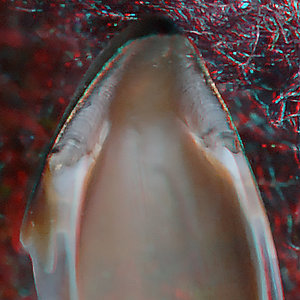 | 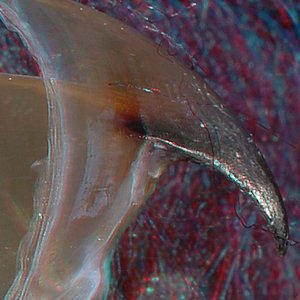 |  |
| Bathothauma lyromma, ? sex, ? mm ML, 2.0 mm URL. LEFT - Oral view | B. lyromma, immature female, 110 mm ML, 2.2 mm URL. MIDDLE - Side view. RIGHT - Oblique view. | |
We use Bathothauma lyromma (above) to represent the first lineage even though it has some peculiar features (probably all members have some peculiar features). The smaller beak (Left) has a large embayment of the Hyaline Matrix (similar to that of Grimalditeuthis, Chiroteuthidae) which does not occur in other Cranchiidae, but creats a distinct Step. The Palatoshoulder Ridge is just reaching the anterior end of the Shoulder at this stage and is covered laterally by the thin wall of the Hyaline Matrix embayment. In the larger beak, the embayment is no longer obvious but the Palatoshoulder Ridge is covered lateraly by Hyaline Matrix. Together, they form the most anterior part of the Shoulder and provide a large lateral Step (Middle). As the Ridge enters onto the Palate it becomes part of a complex, more rounded ridge. This is not a typical Type 1 beak.
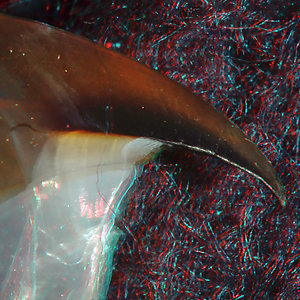 |  | 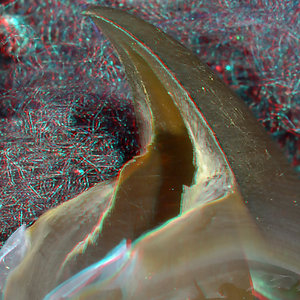 |
| Galiteuthis pacifica, ca. 160 mm ML, 3.1 mm URL. LEFT - Side view. MIDDLE - Oblique view. | G. pacifica, mature male, 333 mm ML, 4.6 mm URL. RIGHT - Oblique view. | |
We use Galiteuthis pacifica (above) to represent the second group (we have not seen beaks of Mesonychoteuthis). In the smaller beak (Left), the Palatoshoulder is the most anterior part of the Shoulder and a distinct Step is present. The Ridge has an irregular free edge that extends from the shoulder well onto the palate. The mature male shows the same condition except that the anterior lead of the Palatoshoulder Ridge is even greater. This is a typical Type 1 beak.
Taonius spp., members of the same clade, have an elongate, curved rostrum which strongly affects the Shoulder structure. While we have not seen well-pigmented beaks, the beaks we have seen have a Step between the Hyaline Matrix and the Jaw Edge and we assume that a Step between the Palatoshoulder Ridge and the Jaw Edge will eventually develop.
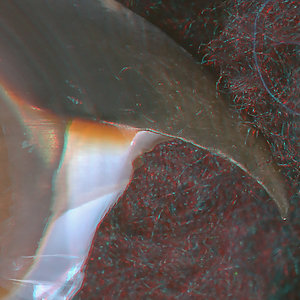 | 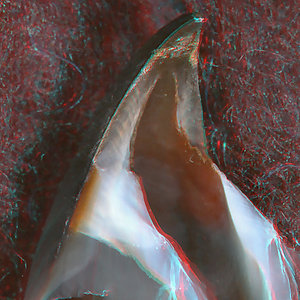 |  |
| Teuthowenia megalops, ? sex, 242 mm ML, 4.6 mm URL. LEFT - Side view. MIDDLE - Oblique view. | Egea inermis, ? sex, 200 mm ML, 2.1 mm URL. RIGHT - Oblique view. | |
In the third lineage, Teuthowenia megalops (above, Left) has a distnct Step (at 40 mm ML, 1.5 mm URL a Step is nearly present). The Palatoshoulder Ridge has a free edge and extends well onto the palate (Middle). This is a typical Type 1 beak. The other two genera in the lineage are well removed from Teuthowenia in general morphology according to Voss (1988). The largest Egea inermis beaks we have seen (Right) has no Step at this size and the Palatoshoulder Ridge has no free edges. Larger beaks need examination to determine if this will develop into a typical Type 1 beak, a beak similar to Megalocranchia fisheri (see below), or a Type 2 beak.
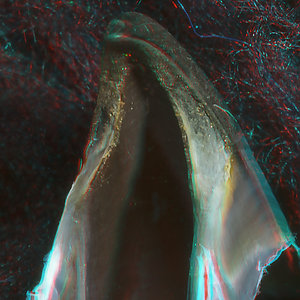 |  |  |
| Megalocranchia oceanica, ? sex, 450 mm ML, 5.7 mm URL. LEFT - Oblique view. | Megalocranchia fisheri, ? sex, 1380 mm ML, 11 mm URL. MIDDLE - Side view. RIGHT - Oblique view. | |
In the last genus of the third lineage, Megalocranchia oceanica (left) the Palatoshoulder Ridge is the most anterior element in the Shoulder and a Step, therefore, is present. The Ridge has a free edge and extends well onto the Palate. This is a typical Type 1 beak. In a large (1.4 m ML) M. fisheri with a well pigmented beak, however, the inner/middle Shoulder is barely visible in side view (Middle, arrows) that creates a very small Step, and the Inner and Middle parts of the Shoulder are fused into a broad, rounded ridge (Right), virtually at the same level as the Shoulder Blade, that seems to blend into the base of the Palate. This beak virtually lies at the separation between Type 1 and Type 2 beaks. It seems unlikely that this beak ever has a typical Palatoshoulder Ridge.
The family contains four genera: Berryteuthis, Eogonatus, Gonatopsis and Gonatus. (Find beaks of Berryteuthis spp. and Gonatopsis borealis under Type 2 beaks.)
 |  | 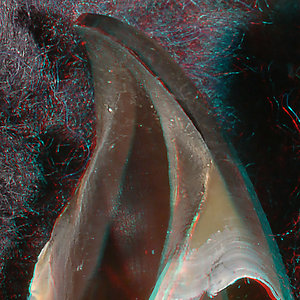 |
| Gonatus berryi, ? sex, 124 mm ML, ? mm URL. LEFT - Side view. MIDDLE - Oblique view. | G. californiensis, ? sex, 315 mm ML, 8.1 mm URL. RIGHT - Oblique view. | |
In Gonatus berryi (above, Left) the Palatoshoulder Ridge is clearly more anterior than the Shoulder Blade (Left) and forms a large Step. The Ridge has a free edge that extends well onto the Palate (Middle). The large and heavily pigmented G. californiensis beak (Right) looks slimilar although the Palatoshoulder Ridge is slightly rounded presumably due to fusion with pigmented material from the Middle Part of the Shoulder. These Gonatus spp. have typical Type 1 beaks.
In small Gonatopsis cf. octopedatus (upper, Left) the Shoulder Blade anteriorly leads in the Shoulder so that no Step is present although a distinct Palatoshoulder Ridge is present. In the beak of the mature adult (Middle) the Shoulder Blade has eroded and the Palatoshoulder Ridge leads the Shoulder creating a Step. The Ridge, which barely has a free edge, extends well onto the palate. In the fully pigmented Eogonatus tinro beak (Right) the Palatoshoulder Ridge leads the Shoulder which forms a distinct Step. The Ridge, although somewhat thickened, extends well onto the Palate; the Ridge shows traces of a free-edge distally. These are fairly typical Type 1 beaks.
1. HISTIOTEUTHID
The Histioteuthidae contains two genera: Histioteuthis and Stigmatoteuthis. Note the peculiar structures seen in the second table below.
 | 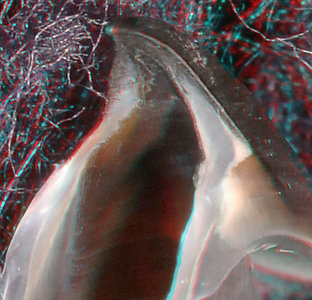 |  |
| Histioteuthis oceani, immature female, 45 mm ML, 2.1 mm URL. LEFT - Side view. MIDDLE - Oblique view. | H. oceani, ? sex, immature, 80 mm ML (estimate), 2.5 mm URL. RIGHT - Oblique view. | |
The small (Left, Middle) and the large (Right beaks of H. oceani (above) show regression of the Shoulder Blade, a Step and a distinct Palatoshoulder Ridge with a free edge that extends well onto the Palate. Note the Shoulder Blade appears to be absent (presumable full regression) in the well-pigmented beak at the Right leaving the sub-Shoulder-Blade layer (see below) exposed.
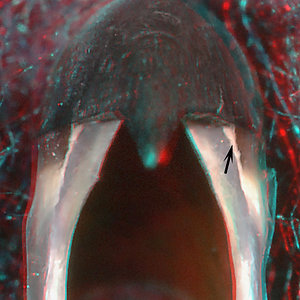 | 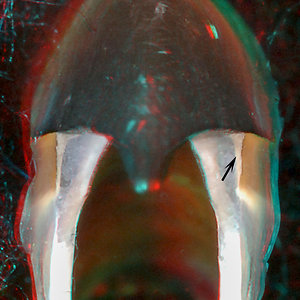 |  |
| H. berryi, immature female, 50 mm ML, 2.4 mm URL. | H. cerasina, immature female, ~80 mm ML, 3.8 mm URL. | Stigmatoteuthis hoylei, immature male, 70 mm ML, 4.6 mm URL. |
Virtually all histioteuthids except for the very young and old, have a peculiar white layer (arrows in above images) underlying part or all of the Shoulder Blade.
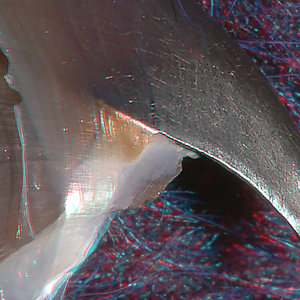 | 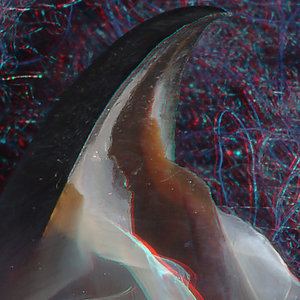 | 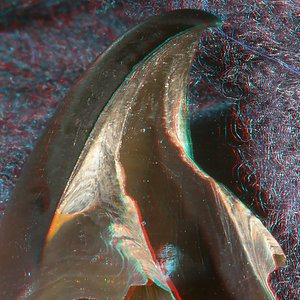 |
| Stigmatoteuthis hoylei, immature male, 70 mm ML, 4.6 mm URL. LEFT - Side view. MIDDLE - Oblique view. | Stigmatoteuthis hoylei, mature female, ? mm ML, 8.6 mm URL. RIGHT - Oblique view. | |
The small (Left, Middle) and large (Right) Stigmatoteuthis hoylei show the same type of shoulder as the previous photos. That is, a typical Type 1 beak. Note the modification of the Shoulder Blade (yellow structure) in the mature female (Right).
2. PSYCHROTEUTHIDAE
The family contains a single genus: Psychroteuthis glacialis.
 |  | 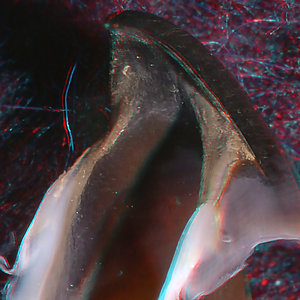 |
| Psychroteuthis glacialis, immature female, 57 mm ML, 2.2 mm URL, oblique view. | P. glacialis, female, 183 mm ML, 5.1 mm URL. LEFT - Side view. RIGHT - Oblique view. | |
We have seen only two beaks of P. glacialis. In the small beak (Left), the Shoulder Blade anteriorly leads the Shoulder; the Palatoshoulder Ridge is absent as expected since there is no posterior pigmentation of the Lateral Wall. The well-pigmented beak of the large squid (Middle, Right) shows an eroded Shoulder Blade and Step but a thick, rounded ridge, presumably formed by the Palatoshoulder Ridge with contributions from the Middle Part of the Shoulder. The Ridge reaches only to the base of the palate. Beaks of intermediate size are need to better understand the structure of this Shoulder, but it is, presumably, a typical Type 1 beak.
The family contains four genera: Alluroteuthis, Neoteuthis, Narrowteuthis, Nototeuthis.
 |  |  |
| Neoteuthis thielei, immature female, 100 mm ML, 2.7 mm URL. LEFT - Side view. MIDDLE - Oblique view. | N. thielei, female mature, 181 mm ML, 4.4 mm URL. RIGHT - Oblique view. | |
In the smaller beak of N. thielei (Left, Middle), the Shoulder Blade anteriorly leads the Shoulder and a distinct Palatoshoulder Ridge is present and close to having a free edge. In the larger beak (Right), the Palatoshoulder Ridge, with a distinct free edge leads the Shoulder and creates a prominent Step. This is a typical Type 1a beak.
We have only a small beak of Alluroteuthis antarcticus (above, Left) which has a large embayment in the Hyaline Matrix which creates a Step. This embayment is present also in small Neoteuthis and we suspect it will be present in young of all members of the family. In the same beak, a narrow Shoulder Blade (difficult is see in this view) is present which reaches only slightly forward of the posterior edge of the embayment. The Palatoshoulder Ridge is not yet formed. The well-pigmented beak of Narrowteuthis nesisi (Middle, Right) shows the Palatoshoulder Ridge anteriorly leading the Shoulder (Middle) to form a distinct Step. The Ridge has a free edge that extends well onto the Palate (Right). This is a typical Type 1 beak.
SURVEY OF BIPARTITE UPPER BEAKS - Type 2
ORDER OEGOPSIDA
2. CHIROTEUTHIDAE: Planctoteuthis
 |  | |
| Planctoteuthis lippula, sex ?, ~40 mm ML, 0.9 mm URL. LEFT - Side view. MIDDLE - Oblique view. | P. lippula, mature female, 70 mm ML, 1.3 mm URL. RIGHT - Oblique view. | |
The Shoulder Blade of the smaller Planctoteuthis lippula (above, Left) is the most anterior part of the Shoulder (Left), therefore no Step is present. The Palatoshoulder Ridge has not yet developed. (Middle). In the mature female (Right), much of the Shoulder Blade has been lost creating a Step between the Palatoshoulder Ridge and the Jaw Edge. This, normally, would indicate that this is a Type 1 beak. However, another specimen, same size and sex has the Shoulder Blade intact. Shrinkage of the Hyaline Matrix of the Middle Shoulder leaves the thin Shoulder Blade vulnerable to loss. Judging from other members of the genus (see below), we suspect that an intact Shoulder Blade is the more typical condition, so the species is considered to have a Type 2 beak.
 | 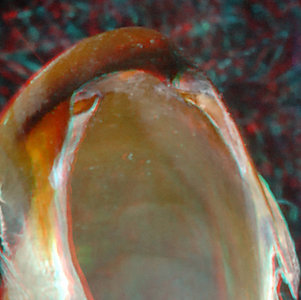 | 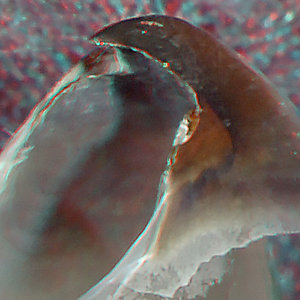 |
| Planctoteuthis oligobessa, sex ?, 75 mm ML, 1.0 mm URL. LEFT - Side view. MIDDLE - Oblique view. | P. oligobessa, mature female, ~65 mm ML, 0.9 mm URL. RIGHT - Oblique view. | |
The Shoulder structure of P. oligobessa (above) is very similar to that of P. lippula. In the smaller beak (Left), the Shoulder Blade is the most anterior part of the Shoulder even though the Palatoshoulder Ridge is well formed (Middle). The mature female (Right) has a convex Palatoshoulder Ridge and a fragile Shoulder Blade (due to the shrinkage of Hyaline Matrix) that is partially broken but the break was insufficient to form a Step. The Palatoshoulder Ridge ends abruptly at the base of the Palate (Right).
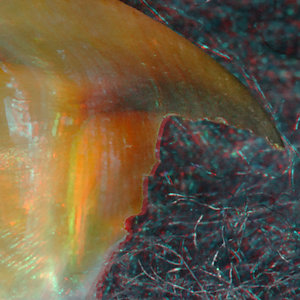 | 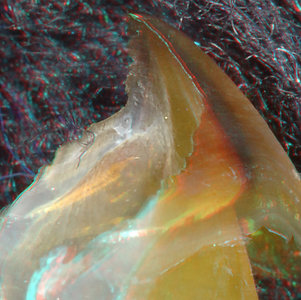 | 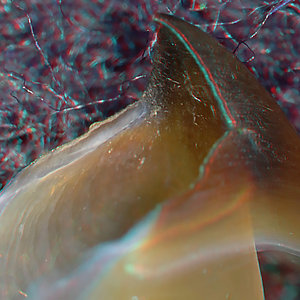 |
| Planctoteuthis danae, immature female, 84 mm ML, 2.0 mm URL. LEFT - Side view. MIDDLE - Oblique view. | P. danae, mature male, 92 mm ML, 1.6 mm URL. RIGHT - Oblique view. | |
In the smaller beak of Planctoteuthis danae the Shoulder Blade leads the Shoulder at its anterior edge (Left). The Palatoshoulder Ridge, however, is prominent; its free edge ends abruptly at the base of the palate (Middle). The Palatoshoulder Ridge of the mature male (Right) is smooth and slightly rounded and, also, ends at the base of the Palate. The Hyaline Matrix is greatly reduced leaving the two parallel ridges with little between them. There is no Step on either side of the beak but the sides are not mirror images. The beaks of the Planctoteuthis species examined are all similar and qualify as Type 2 beaks but they are not typical of this type.
4. MAGNAPINNIDAE
The family has a single genus: Magnapinna.
 | 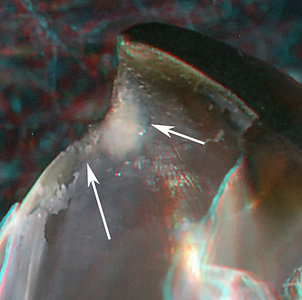 | 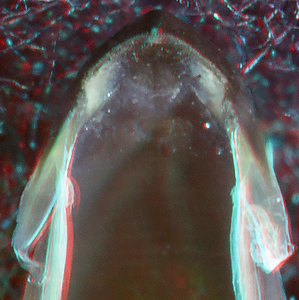 |
| Magnapinna atlantica, immature male, 72 mm ML, 1.0 mm URL. LEFT - Side view. MIDDLE - Oblique view. Arrows - Edge of Palatoshoulder Ridge. RIGHT - Front- oblique view. | ||
In the smaller beak of Magnapinna atlantica (above), the Shoulder Blade is the most anterior part of the Shoulder (therefore, no Step is present) (Left). The Palatoshoulder Ridge is weakly defined (Middle arrows, Right) and may merely indicate a late stage in the pigmentation of the Shoulder (i.e., the Hyaline Matrix has begun to sclerotize in the region of the lower arrow). More data is needed to properly determine beak type.
 |  | 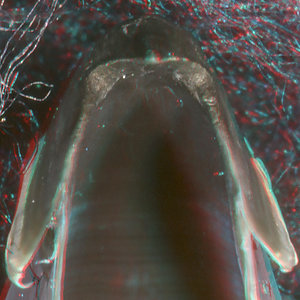 |
| M. atlantica, mature male, 127 mm ML, 1.7 mm URL. LEFT - Side view. MIDDLE - Oblique view, RIGHT - Front-oblique view. | ||
In the adult of M. atlantica (above), the pigmented Outer Shoulder is barely anterior to the remaining shoulder (Left). A Palatoshoulder Ridge cannot be clearly recognized. (Middle, Right). This beak is tentatively identified as a Bipartite Type 2 beak but more evidence is needed.
5. PROMACHOTEUTHIDAE
The family has a single genus: Promachoteuthis
 |  |
| Promachoteuthis sloani, immature female, 102 mm ML, 4 mm URL. LEFT - Side view. RIGHT - Oblique view. | |
Our largest specimen (the largest known in the family) of P. sloani (above) was not mature even though its beak is heavily pigmented. The Shoulder Blade is difficult to recognize as its dorsal edge, usually marked by the Jaw Edge Extension, is not visible. Nevertheless, the Shoulder Blade clearly leads the Shoulder anteriorly (Left) and no Step is present. The Palatoshoulder Ridge is well developed and has a free edge that extends onto the pallet. This is a typical Type 2 beak at this stage of development.
Species in two genera, Berryteuthis and Gonatopsis, appear to have Type 2 beaks.
| Berryteuthis magister, ? sex, ? mm ML, 5.9 mm URL. LEFT - Side view. MIDDLE - Oblique view. | Gonatopsis borealis, ? sex, ? mm ML, 5.6 mm URL (broken tip). RIGHT - Oblique view. | |
In the largest beak of Berryteuthis magister (above) that we have seen (i.e., 5.9 mm URL) the pigmented Outer Part of the Shoulder (the Should Blade is no longer recognizable) is the most anterior part of the shoulder (Left), hence, no Step is present. The Palatoshoulder Ridge is distinct but a free edge not apparent (Middle). Little of the Hyaline Matrix remains suggesting that the Shoulder structure will not change greatly in older beaks. The largest of Gonatopsis borealis beak (Right) that we have seen is very similar and, also, is unlikely to change greatly in older beaks.
ORDER - SPIRULIDA:
This family contains a single species, Spirula spirula.
In the large male of S. spirula (above Left, Middle), the heavily pigmented Outer Shoulder is clearly the most anterior part of the Shoulder (Left) therefore no Step is present. The Palatoshoulder Ridge is barely recognizable (Middle, arrow) and most the of the Hyaline Matrix is gone suggesting the beak will not change much in larger squid. In the younger, less pigmented beak (Right) the Palatoshoulder Ridge is apparent (arrow); note that the Ridge is lightly backlit, by light scattering off the Hyaline Matrix, indicating that it is covering part of the medial side of the Matrix.
Details of the structure of the Shoulder of this beak can be found in the Bipartite Upper Beak page.
ORDER UNCERTAIN, Superfamily - Bathyteuthoidea:
This family contains a single genus, Bathyteuthis.
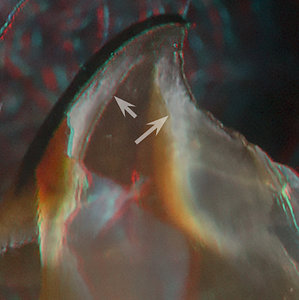 | 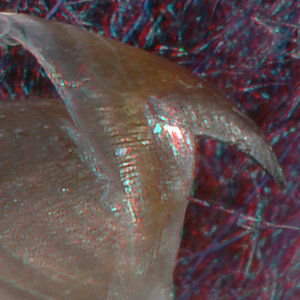 |  |
| Bathyteuthis sp., 33 mm ML, 0.9 mm URL. LEFT - Oblique view. | Bathyteuthis berryi, 53 mm ML, 0.8 mm URL, Hawaiian waters. MIDDLE - Side view. RIGHT - Oblique view. | |
The Shoulder of the partially pigmented beak of Bathyteuthis sp.(above, Left) has a narrow but distinct Palatoshoulder Ridge (arrow) (note the translucency of this layer from the back-scatter of light off the Hyaline Matrix). The Shoulder of the well-pigmented beak of B. berryi (Middle, Right) has the Outer Shoulder as the anteror-most structure of the Shoulder, therefore no Step is present. This beak has a still recognizable Palatoshoulder Ridge (arrow) that extends onto the Palate.
Details of the structure of the Shoulder of this beak can be found in the Bipartite Upper Beak page.
SURVEY OF BIPARTITE UPPER BEAKS - Type 3
ORDER - Oegopsida:
The family has two genera: Brachioteuthis and Slosarczykovia. Only the former has a Type 3 beak.
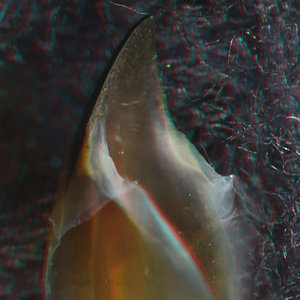 | 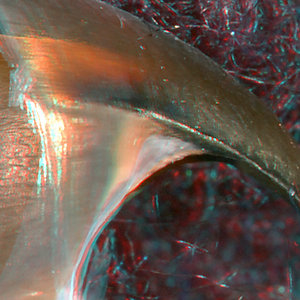 |  |
| Brachioteuthis cf. beanii. LEFT - Oblique view, male, 70 mm ML, 1.9 mm URL. | B. cf, beanii, female, 114 mm Ml, 2.6 mm URL. MIDDLE - Side view, RIGHT - Front-oblique view. | |
Left - At 70 mm ML Brachioteuthis cf. beanii, exhibits no obvious Step and no clear Palatoshoulder Ridge in spite of the nearly fully pigmented Lateral Wall. The posterior surface of the Hyaline Matrix is pigmented as well. This latter pigmentation is easily seen in the above image through the very transparent Hyaline Matrix. At 114 mm ML (Middle, Right), the virtually fully pigmented beak has a large Step, however the apparent Palatosholder Ridge seems to be a complex of the pigmented Lateral Wall fused with pigmented medial edge of the Hyaline Matrix. The transparent Hyaline Matrix remains only as a rather thin layer on the anterior surface of the Middle Part of the Shoulder. A true Palatoshoulder Ridge is unlikely to be present in an intervening stage.
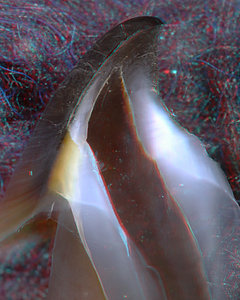
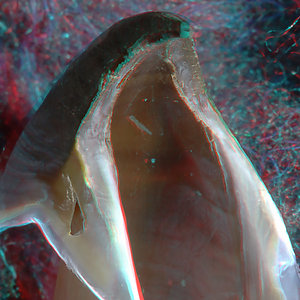

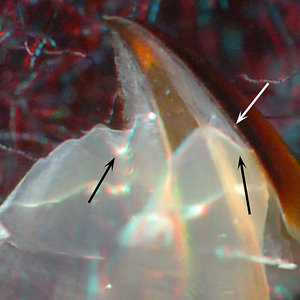
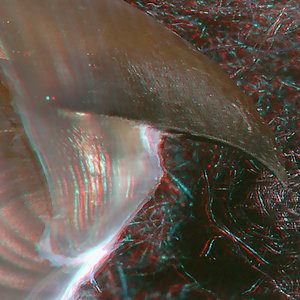
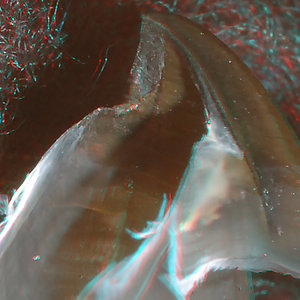
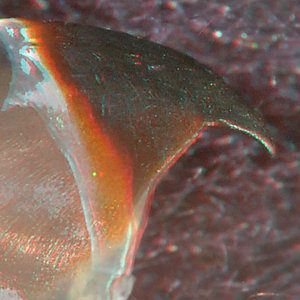

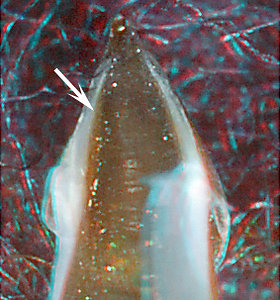


 Go to quick links
Go to quick search
Go to navigation for this section of the ToL site
Go to detailed links for the ToL site
Go to quick links
Go to quick search
Go to navigation for this section of the ToL site
Go to detailed links for the ToL site